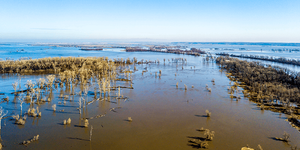Flood Damage Estimate Soars to $12 Billion
 AccuWeather estimates the total damage and economic loss caused by record-breaking flooding in the Midwestern U.S. this spring will total $12.5 billion, based on an analysis of damages already inflicted and those expected by additional flooding, as well as the lingering health effects resulting from flooding and the disease caused by standing water.
AccuWeather estimates the total damage and economic loss caused by record-breaking flooding in the Midwestern U.S. this spring will total $12.5 billion, based on an analysis of damages already inflicted and those expected by additional flooding, as well as the lingering health effects resulting from flooding and the disease caused by standing water.
AccuWeather’s damage estimate factors in official states’ estimates while incorporating independent methods to evaluate all direct and indirect impacts of the flooding damage based on a variety of sources and statistics.
The flooding erupted in the wake of a historic bomb cyclone and the economic damage rivals that of some of the worst hurricanes to hit the U.S. The $12.5 billion estimate for flooding this spring would compare to Hurricanes Matthew (2016) and Irene (2011).
“Our decades of experience forecasting high-impact weather events and witnessing the damage left behind enable us to calculate damage estimates that have proven to be the most accurate,” said Dr. Joel N. Myers, AccuWeather founder and CEO. “These losses occurred in farm states that contribute significantly to the nation’s Gross Domestic Product. With the ground already saturated and more flooding rain expected, our independent forecast shows that the aggregate economic toll of these floods will be far greater than official estimates initially suggest. Official estimates of damage do not fully take into account uninsured losses as well as lost work hours and damage sustained by contaminated water, in addition to a range of other direct and indirect impacts.”
AccuWeather’s $12.5 billion estimate includes damage to homes, their contents, and cars, business and farm losses – including crops and livestock – contamination of drinking water wells, infrastructure damage, auxiliary business losses and the long-term impact from the flooding, which will likely contribute to, and exacerbate, health issues.
Devastating flooding in Iowa, Nebraska, Wisconsin and Missouri this spring already has led to billion-dollar damage estimates in those states, according to officials. “When we look at the crop losses, the lost economic activity, it quickly climbs above $2 billion,” Iowa Farm Bureau senior economist Sam Funk told The Des Moines Register.
Nebraska Governor Pete Ricketts, who said the flooding aftermath was “the most extensive damage our state has ever experienced,” initially requested $1.3 billion in federal disaster funding (though that number ultimately may be lower). Nebraska’s Offut Air Force Base suffered an estimated $1 billion in damages and officials in Wisconsin estimate the damage in their state at $1.9 billion.
Other states impacted so far include Montana, North Dakota, South Dakota, Minnesota, Illinois, Indiana and Kansas. At least 1 million acres of farmland were flooded and more than 1 million private water wells may be contaminated.
River basins from the Dakotas, Montana and Minnesota to the Midwest and Mississippi Valley are experiencing river and stream flooding. And with heavy early spring rainfall expected to continue in a large portion of these areas along with snowmelt with high water equivalents in many areas, flooding problems in the streams and rivers of the central U.S. are expected to worsen in April, according to AccuWeather meteorologists.
Frequent rain events forecast throughout spring will increase the likelihood of flooding in Arkansas, Tennessee, Kentucky, Louisiana, Alabama and Mississippi.
Rivers that already have flooded or could experience major flooding this spring include the Illinois, Red, Missouri, Platte, Wabash, Ohio and Mississippi. Even without any additional rain, these rivers may remain above major flood stage through the middle of April and may not fall below flood stage in some cases until the middle to latter part of May, AccuWeather meteorologists caution.
Other states that could see spring flooding include Oklahoma, Texas, Georgia, Florida, and California, according to AccuWeather meteorologists.
Source: AgriMarketing
